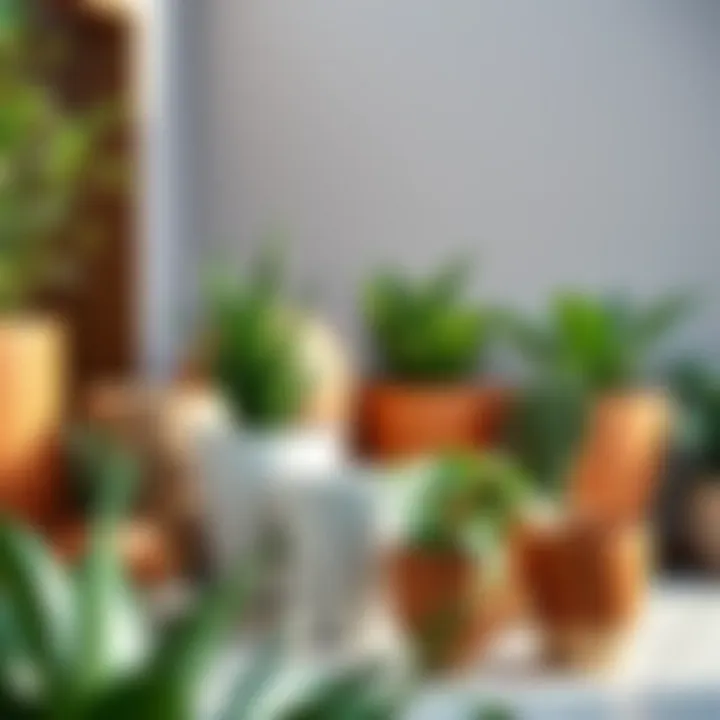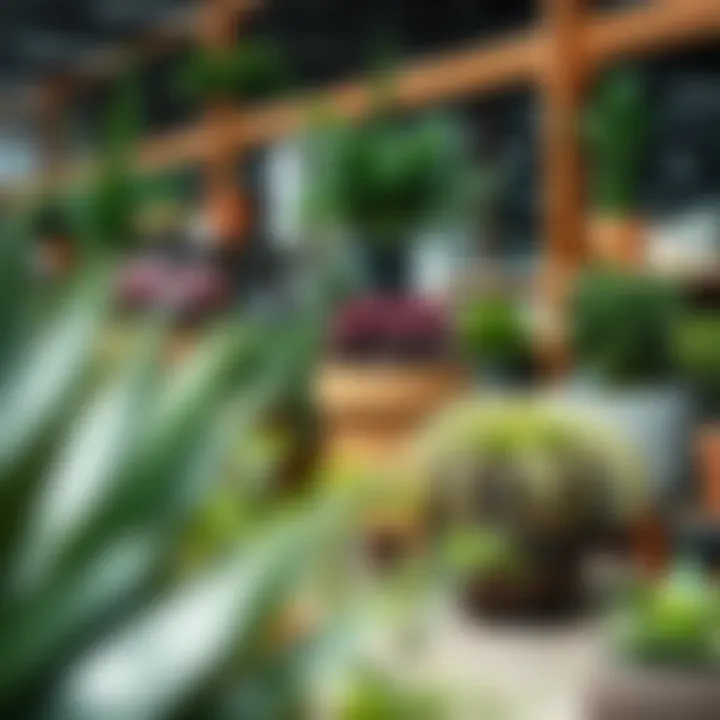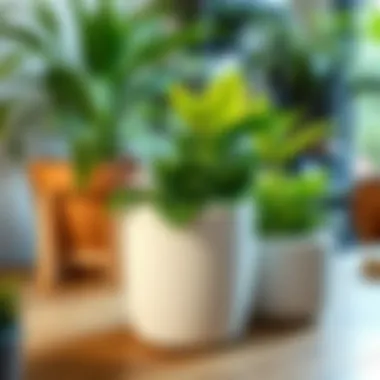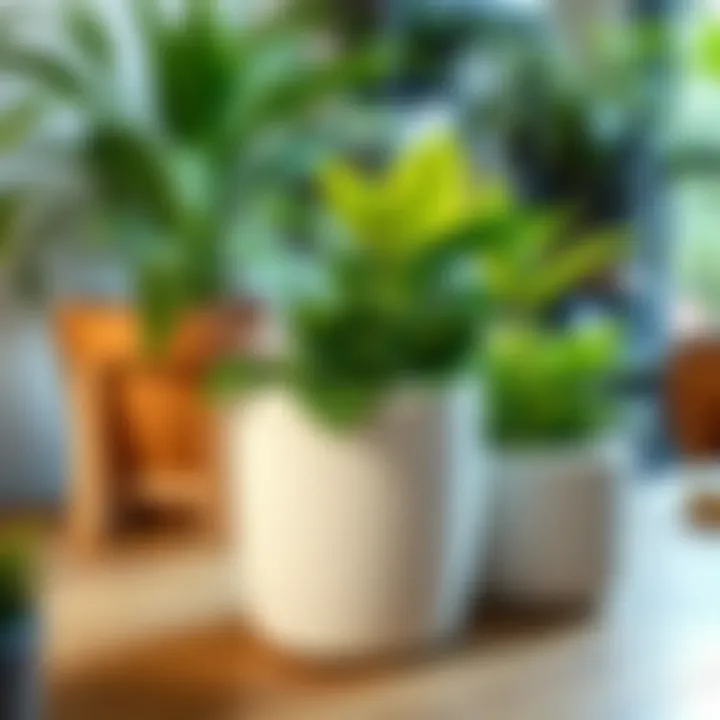Discounted Large Planters: A Guide for Enthusiasts


Intro
In the ever-evolving world of home décor, large planters have emerged as standout pieces that not only hold greenery but elevate a space’s aesthetic. Understanding how to source them wisely, particularly at discounted rates, is essential for furniture enthusiasts who want to make their living environments blossom without breaking the bank. This guide seeks to dissect the multifaceted approach to securing large planters at attractive prices, while also delving into the types of planters that can complement various interior styles.
More than mere decorations, planters can serve as focal points or subtle additions to enhance the overall theme of a room. The nuances of choosing the right one, the materials employed, and the discounts available can significantly influence the final outcome in a living space. It’s not just about the savings; it’s about understanding your needs and tastes, ensuring that the choices render a harmonious living atmosphere.
For those with a keen eye for interior design or a desire to create a colorful ambiance in their homes, this guide will offer insightful strategies to navigate the discount market for large planters, helping you cultivate a beautiful space at a fraction of the cost.
Understanding Large Planters
Large planters represent a blend of functionality and design, offering unique opportunities for both homeowners and interior decorators. In this context, understanding the nuances of large planters can help individuals make informed choices that enhance their living spaces. This section delves into various aspects, including types, benefits, and key considerations when selecting a large planter, empowering readers to navigate the world of home décor more effectively.
Types of Large Planters
Material Options
When it comes to large planters, material options play a pivotal role in both aesthetics and practical use. Common materials include ceramic, wood, plastic, and metal. Each of these materials come with their own pros and cons. For instance, ceramic offers a classic, elegant look, and is weighty enough to withstand outdoor conditions. On the flip side, it can crack in extreme temperatures.
Wooden planters bring warmth and natural charm to a space, making them a top choice for those with a rustic flair. However, untreated wood may deteriorate outdoors. Plastic options are lightweight and come in a plethora of colors and designs, appealing to budget-conscious buyers, but they may lack the visual appeal of more expensive materials. Metal planters are sturdy and modern but can overheat or corrode in certain climates.
Shapes and Designs
Shapes and designs contribute significantly to the overall impact of large planters. Common shapes include cylindrical, rectangular, and even artistic forms that can serve as statement pieces. A cylindrical planter can benefit from its balanced look, suitable for nearly any type of plant. In contrast, rectangular designs are often favored for their space-saving abilities, especially on patios or balcony railings.
Unique designs, such as tiered or geometric shapes, can add an unexpected twist to an area. However, potential buyers should consider how these shapes align with their existing décor, as mismatched styles can lead to a visual disarray.
Functional Features
The functional features of large planters often distinguish the great from the mediocre. Look for options equipped with drainage holes to prevent waterlogging, which can harm the plants. Self-watering systems are also gaining attention, allowing busy homeowners to maintain plant health with less manual effort.
Moreover, some planters come with built-in handles or removable liners that provide practical benefits during transportation and maintenance. While these features can add to the initial cost, they may greatly enhance usability for the long term.
Benefits of Using Large Planters
Maximizing Space
Large planters present an efficient way to utilize space, especially in urban settings where every inch counts. They can transform small balconies or patios into luscious green retreats. Utilizing vertical space through multi-level planters can also create an impression of expansion without requiring a larger footprint.
Moreover, grouping different plants in a single large planter creates a mini-garden effect while reducing the clutter often created by multiple smaller pots. This not only saves on space but also reduces maintenance by concentrating watering and feeding efforts to one area.
Enhancing Aesthetic Appeal
The visual impact of large planters can’t be overstated. They add character and a focal point to living areas, enriching both indoor and outdoor environments. Strategically placed planters can frame entryways, soften hard edges of structures, and even serve as a barrier without obstructing views.
A well-chosen planter can also complement the architectural style of a home or garden. For instance, a sleek modern planter may enhance the sharp lines of minimalist décor, while a rustic wooden planter might harmonize beautifully with a traditional farmhouse aesthetic.
Encouraging Plant Growth
Large planters are more than mere decorative elements; their size supports healthier plant growth. With more soil volume, plants have access to greater nutrients and moisture, allowing for robust root systems. This becomes especially crucial for larger plants or shrubs, which thrive in less confined environments.
Additionally, well-designed large planters often maintain better moisture levels, reducing the risk of drought stress. This, in turn, leads to less frequent watering and ultimately a more successful growing experience.
The Appeal of Discounts
Discounts hold a fundamental allure for many individuals, particularly when it comes to purchasing large planters for enhancing home aesthetics. They serve to shrink the financial impact of what can otherwise be a hefty expenditure. For furniture enthusiasts, understanding the appeal of discounts is crucial—both as a means of obtaining desired items and for the satisfaction that comes from smart financial decisions.
Ultimately, seeking discounts can be looked at from various angles, providing multiple advantages that go beyond mere price reductions. To effectively navigate this realm, it's important to consider the reasons behind seeking discounts, as well as how these discounts affect perceptions of quality and brand reputation.
Why Seek Discounts?
Budget Considerations
When it comes to making a purchase, particularly big-ticket items like large planters, budget considerations are often at the forefront of decision-making. The reality is that many homeowners and decorators face financial constraints and look for ways to stretch their dollars without compromising quality.
With discounts, individuals can find high-quality planters at prices that align more closely with their financial capabilities. This creates a win-win situation where one can splurge a little more on plant care or soil quality without feeling guilty about emptying their wallets.
Some may view this pursuit as savvy spending, a strategy embraced by many who are looking to enhance their outdoor or indoor spaces on a budget. However, one should be cautious as not all discounts guarantee high-quality products, hence careful research remains necessary.
Value for Money


In the world of consumer goods, value for money is often the golden ticket. Finding discounts that align with valuable products enables consumers to enjoy their purchases without feeling they've overpaid. For large planters, this means getting an item that not only beautifies a space but also lasts longer and requires less upkeep, offering a greater return on investment.
When buyers perceive that they are receiving exceptional value, their satisfaction increases, and they are more likely to share their experiences, creating a ripple effect that benefits sellers and brands alike. Among furniture enthusiasts, discussing quality and value is a commonly shared topic, which further highlights the importance of seeking discounts wisely. However, the challenge is ensuring that a lower price doesn't compromise the integrity or quality of the item purchased.
Impacts of Economic Conditions
The economic climate can greatly influence purchasing decisions. Economic times that are tough, such as recessions, prompt shoppers to become more alert to discounts as they prioritize essential items over luxuries. In such conditions, discounts become more than a perk; they're often essential for maintaining a desired lifestyle.
During these times, large planters may see a significant fluctuation in demand, so consumers actively seek out deals that ensure they can continue to beautify their surroundings without throwing their financial plans out of balance. While it's tempting to rush toward the cheapest options, one must remain mindful of overall quality and functionality, maintaining a balance between price and desirability.
Perceptions of Quality with Discounted Items
Quality Assurance
One prevalent concern among consumers eyeing discounts relates to quality assurance. The assumption that a discounted item is of inferior quality can deter potential buyers. However, many reputable brands engage in discounting as a means of introducing new collections or clearing stock, which doesn't necessarily imply that the product in question is subpar.
In fact, consumers should look for warranties and guarantees provided by manufacturers as indicators of confidence in their products. Solid brands recognize the importance of quality assurance, knowing that satisfied customers are key to long-term success in the marketplace.
Consumer Trust
Trust plays a pivotal role in shaping consumer behavior. When navigating the terrain of discounted items, trust can fluctuate based on past experiences. Shoppers lean towards retailers with solid reputations, knowing that they are likely to receive both a quality product and a good deal. On the flip side, a bad experience with a discount can lead to skepticism.
Developing trust may take time, but savvy consumers often establish a list of go-to retailers that reliably deliver quality at a fair price. Thus, having a track record of trust in discounted items can be a significant draw when seeking large planters.
Brand Reputation
Brand reputation directly influences the perceived value of discounts. A well-established brand known for its quality products can attract buyers to its discounted large planters, as consumers may feel more secure investing in items from recognized names. A strong brand reputation fosters confidence, suggesting that even on sale, their products will meet expected standards.
On the other hand, lesser-known brands entering the discount game may struggle to convince consumers of their worth. Hence, while discounts can attract attention and draw sales, brands must work diligently to ensure that their reputation remains intact to capitalize on this potential. In summary, understanding these facets of brand reputation aids buyers in navigating their options wisely.
Where to Find Discounts on Large Planters
Finding the right discounts on large planters can feel like hunting for a needle in a haystack. But it doesn't have to be all that tricky, especially when you know where to look. This section sheds light on crucial avenues for snagging those deals, ensuring that your dream planter doesn’t break the bank. Getting a good deal might not just save you money; it might also allow for some creative freedom in how you decorate your space.
Seasonal Sales and Promotions
Spring and Summer Deals
Spring and summer are prime seasons for gardening enthusiasts and decorators alike. Retailers often clear out old stock to bring in fresh inventory. This translates to significant discounts on a variety of large planters. Whether it's ceramic, resin, or wood, you're likely to see prices slashed as folks get ready to spruce up their outdoor and indoor greenery.
- Key Characteristic: The allure of seasonal sales lies in the sheer volume of options available. You'll find everything from trendy modern designs to classic, rustic styles all discounted.
- Unique Feature: These deals often coincide with gardening fairs and local plant sales, making it a fantastic time for community engagements as well.
- Advantages: Buying during this time means you can score quality planters at a fraction of their usual price, while also possibly picking up some plants or gardening tips.
Holiday Discounts
Holiday sales bring a whole different flavor of savings. During these times, companies tend to offer discounts as a way to lure in consumers who are shopping for gifts or home improvements.
- Key Characteristic: Holidays often come with extended sales periods, allowing for more window-shopping before committing.
- Unique Feature: Discounts can sometimes stack with promotional offers, making it a sweet spot for getting large planters at killer prices.
- Advantages: You might also find bundle deals that allow you to buy planters and plants together, fostering a more complete shopping experience.
End-of-Season Sales
As the gardening season winds down, retailers often attempt to clear out their seasonal inventory through end-of-season sales. These discounts can be a gardener’s best friend.
- Key Characteristic: Products that had their heyday during spring and summer often become steeply discounted as fall approaches.
- Unique Feature: Retailers want to make space for winter merchandise, which results in markdowns that are hard to resist.
- Advantages: It presents a unique opportunity for budget-conscious shoppers to invest in planters they can use for seasonal decorating or next year’s gardening projects.
Online Marketplaces Overview
E-commerce Platforms
E-commerce platforms have revolutionized how we shop for everything, including large planters. Their wide reach connects buyers to discounts from vendors around the globe.
- Key Characteristic: They allow consumers to compare prices with just a few clicks, making it easier to find that perfect planter at the best price.
- Unique Feature: Many platforms have user reviews, which can provide insights into the quality of the planters beyond just what the photographs show.
- Advantages: You usually have a wider selection in terms of styles and sizes which can meet various aesthetic needs, but watch for shipping fees that might cut into your savings.
Specialty Websites
Niche websites often focus specifically on home and garden articles. They frequently have exclusive deals on large planters that are not available on general e-commerce platforms.
- Key Characteristic: These sites tend to have curated collections, making it easier to find unique or artisanal planters.
- Unique Feature: Some specialty websites offer seasonal subscriptions or regular sales to members, further enhancing the potential for savings.
- Advantages: You'll be able to discover rare pieces that align closely with specific styles, which can be a big plus for design enthusiasts.
Second-Hand Markets
Second-hand markets offer a treasure trove of opportunities for finding unique large planters at extremely low prices.


- Key Characteristic: These platforms attract those looking to sell their gently used items, meaning you can often negotiate prices.
- Unique Feature: Vintage or antique planters with a story can be found that aren't available in typical stores.
- Advantages: By shopping second-hand, you not only save money but contribute to sustainability, making it an admirable choice for eco-conscious consumers.
Local Stores and Garden Centers
Community Discounts
Local garden centers often have community discounts for residents. These might not only apply to large planters but can include various gardening accessories as well.
- Key Characteristic: They usually offer membership discounts or loyalty programs that provide added savings.
- Unique Feature: There’s often a more personal touch, with staff being well-informed and able to advise on the best options for your space.
- Advantages: Building relationships can lead to insider info about future sales or exclusive discounts that might not be advertised.
Bulk Purchase Benefits
Buying in bulk can yield substantial savings when it comes to purchasing large planters, especially for individuals or businesses looking to decorate multiple spaces.
- Key Characteristic: Many retailers offer tiered pricing where the more you buy, the less you pay per item.
- Unique Feature: This is usually a win-win situation both for decoration enthusiasts needing multiple planters and retailers wanting to move stock quickly.
- Advantages: It allows for cohesive design themes across various plants and decor, all while keeping costs manageable.
Local Sales Events
Check websites for local nurseries and garden centers that may host sales events. These events can vary from plant swaps, open house sales, and yard sales.
- Key Characteristic: Often community-based, exciting discounts are available that are not found in standard retail settings.
- Unique Feature: Attending local events can be a fun outing and a chance to meet fellow gardening enthusiasts.
- Advantages: You get the chance to browse a variety of planters while possibly learning more about plants and gardening in the process.
DIY Options for Creating Large Planters
Creating large planters on your own is not just a fun weekend project; it's a practical approach to enhance your home, all while saving a few bucks. Engaging in DIY allows you to customize your planters to fit your space, style, and plant requirements exactly. In a world full of mass-produced items, handcrafting your own can bring a unique flair that commercial options might lack. Not to mention, repurposing materials is an eco-friendly choice, which resonates with many people today.
In this section, we will dive into various methods of crafting large planters. This includes repurposing household items that you might otherwise toss out or consider scrap wood and concrete forms for building planter boxes from scratch.
Repurposing Household Items
Repurposing everyday household items into planters is a dynamic and resourceful way to get creative while being budget-conscious.
Old Buckets and Tubs
Using old buckets and tubs is a prime example of giving new life to items gathering dust in your garage or shed. These materials are easily available, usually lingering in many homes without purpose. A crucial benefit to buckets is their depth, allowing for a diverse array of plants, from deep-rooted herbs like basil to colorful flowers.
However, it’s essential to keep drainage in mind. A well-drained planter is a happy planter. You can achieve this by drilling holes at the bottom to let excess water escape. On the flip side, keep in mind that metal buckets can get pretty hot under intense sunlight, affecting the soil temperature. Therefore, providing some shade or using insulation could be beneficial.
Wooden Pallets
Wooden pallets present another excellent opportunity for DIY planters, particularly for those looking for large, rustic designs. Pallets are typically inexpensive, and with a bit of effort, they can convert into stunning vertical or horizontal planters. The open structure of pallets makes them especially favorable for plants that thrive with good air circulation.
One downside lies in their durability; untreated wood may deteriorate over time if exposed to moisture. A coat of sealant can help, but ensure it's safe for the plants you intend to grow. When completed, pallet planters not only serve as functional pieces but can also be quite aesthetic in gardens or terraces.
Concrete Forms
Concrete forms are another strong choice for those aiming for something sturdy. The strength of concrete makes it a long-lasting option, perfect for larger plants or small trees that need stability. This material can be molded into various shapes and sizes, adding a sleek yet modern twist to your home or garden.
On the downside, concrete is not lightweight. This can pose a challenge when moving or rearranging your planters. However, adding drainage holes is a must to prevent water from pooling at the bottom. Besides, consider mixing in some paint or decorative finishes to avoid that stark "industrial" look, allowing for a more refined appearance in your backyard setup.
Building from Scratch
If you can’t find materials to repurpose or prefer making something from scratch, you’ve got options too. Let’s discuss how to tackle the material selection, construction techniques, and finishing touches that will take your DIY project to the next level.
Material Selection
Choosing the right materials is foundational when you’re building DIY planters. Factors like weight, durability, and how the material withstands weather conditions come into play. For instance, wooden boards are lightweight and provide a rustic aesthetic; however, they may require treatment against rot and pests. Alternatively, using recycled plastics is light and weather-resistant but might not offer the same visual appeal as natural materials. Choosing materials that resonate with your home décor will create coherence in your design.
Construction Techniques
The construction method you use can significantly influence your final product. Techniques can range from simple cutting and screwing to more intricate joinery. Beginners might start with basic rectangular shapes, while advanced DIYers could experiment with curved forms or tiered designs. Be careful to check for stability as you assemble your items, particularly if they will hold heavier plants.
Finishing Touches
Once your planter is built, the finishing touches can elevate your project entirely. Adding paint, varnish, or decorative stones not only enhances the overall appearance but also provides a layer of protection to the materials used. Many homeowners choose to stencil designs or patterns which can personalize their planters further, making them unique features in their gardens.
Creating large planters through DIY methods not only saves costs but also nurtures creativity. With a little effort and thought, you can craft designs that are reflective of personal style and practical in functionality.
Factors to Consider When Purchasing Large Planters


When shopping for large planters, several elements come into play to help select the right one for your needs. Think about this aspect carefully because it often determines the overall look and function of your space. By honing in on these factors, you ensure not just a greener environment but also a stylish one.
Size and Scale
Assessing Space Requirements
Evaluating space requirements is a critical step in selecting large planters. A planter that's too big for your area can overwhelm the room, while one that’s too small may seem lost in the space. Paying attention to space allows for a more harmonious integration in your home. Consider how your chosen plants will develop; a larger planter can offer ample room for roots, promoting healthier growth. A beneficial point here is to take measurements of your intended area before making a purchase. An often-ignored detail, measuring prevents buying on impulse, saving you possible disappointment later.
Understanding Plant Needs
Understanding the needs of your plants plays a pivotal role in choosing the correct large planter. Different types of plants require different levels of soil depth and space. For example, a tall plant like a fiddle leaf fig needs a deeper pot than a sprawling succulent. Accounting for this aspect guarantees that your plants will thrive, avoiding unnecessary stress which can arise from a cramped living situation. Therefore, focus on the plant's growth habits; go for a planter that complements those needs.
Proportional Aesthetics
Proportional aesthetics is key when designing your space. The size of your planters should relate well to the room’s features. For instance, in a spacious living room, a small planter might disappear visually. Conversely, an oversized planter in a compact bathroom could create a cluttered feeling. Finding the balance is essential; a good rule of thumb is to aim for a planter that occupies roughly one-third of the space available. This consideration not only ensures a pleasing look but also enhances your overall design aesthetic.
Drainage and Maintenance
Importance of Drainage Holes
The necessity of drainage holes cannot be overstretched. Without these features, excess water can accumulate, leading to root rot and other plant ailments. Drainage is essential for plant health; a well-drained large planter allows for proper air circulation and aids in root establishment. It’s a popular choice among seasoned gardeners to favor planters with built-in drainage systems. When examining a potential purchase, double-check that it offers this crucial feature.
Water Retention Strategies
Water retention strategies are important when deciding on materials for large planters. Some materials naturally retain moisture better than others. For instance, clay pots provide excellent aeration but may dry out too quickly in sunny areas. Conversely, plastic and resin planters can hold moisture efficiently but may lack the breathability that some plants require. Balancing moisture retention with adequate drainage can lead to healthier, more vibrant plants.
Cleaning and Upkeep
Cleaning and upkeep are vital for maintaining the appearance and health of large planters. Over time, soil debris and algae can build up, looking unsightly and possibly harming the plants. Regular maintenance not only ensures your spaces look fresh but also helps avoid pests that can be attracted to dirty planters. Opting for materials that are easy to clean can make this chore less daunting. Many people find it beneficial to simply wipe down their planters every so often, keeping their garden in tip-top shape.
Style and Design Compatibility
Matching Home écor
When choosing large planters, it’s essential to consider how they fit within your existing home décor. Planters available in various materials and styles can either clash or complement your surroundings. Bringing harmony to your interior can help elevate the entire aesthetic. Many decorators recommend using planters that either match or contrast harmoniously with existing furniture. This creates a flow in design, enhancing the overall living experience.
Color Considerations
Color considerations are paramount when integrating large planters into your space. The right hue can either make your plants pop or blend into the background. Consider the color palette of your room; if your walls are neutral, you might want to choose a vibrant planter to draw the eye. Conversely, if your furnishings are colorful, opting for a more subdued shade can maintain balance. Keep in mind that plants themselves also present an array of shades, which further emphasizes the importance of color selection.
Trends in Planter Design
Staying aware of trends in planter design can offer fresh inspiration when it comes to selecting your planters. Popular styles vary from rustic wooden designs to sleek, modern fiberglass. Understanding these trends can help choose a planter that not only meets functional needs but also aligns with current design aesthetics. While it may be tempting to follow every trend, remembering to select what suits your personal taste will ultimately result in a satisfying choice.
Final Thoughts on Large Planters and Discounts
As we draw this exploration on large planters and their discounts to a close, it becomes clear that the decisions taken in this area carry weight. A large planter is not merely a vessel for plants; it is a statement piece that enhances the environment at home or in business settings. Finding the right one at a price you can afford is key, as it allows one to enjoy the beauty of greenery without breaking the bank.
Evaluating Your Options
Conducting Research
When considering large planters, conducting research plays a pivotal role. Engaging in thorough research on the materials available, styles suited to your space, and price comparisons can pay off significantly. This step pushes you to be informed about your best options—actively seeking out reviews and recommendations from professionals and fellow enthusiasts in the gardening community. The beauty of research lies in its ability to uncover hidden gems; perhaps you'd stumble upon a local supplier offering unique handcrafted planters at a fraction of the price found at big box stores. While it means investing time into gathering information, the potential savings and satisfaction justify the effort.
Making Informed Decisions
Once you've gathered a wealth of information, the focus shifts to making informed decisions. This aspect encapsulates evaluating your findings and weighing which factors matter most to you—style, functionality, budget, and sustainability. Making thoughtfully tailored choices results in not just a planter, but a piece that complements your lifestyle seamlessly. The key here lies in knowing what aligns best with your needs, and that means sometimes putting practicality over aesthetic preference. This balance can be tricky but fortuitously leads to longer-term satisfaction with your purchase.
Aligning with Personal Style
Personal style is often the icing on the cake when it comes to selecting large planters. Options are vast, from bohemian to modern minimalist, and finding a planter that resonates with your unique taste can elevate the overall aesthetic of your living or working space. This attention to design not only pleases the eye but also invigorates your personal environment, creating a space that feels distinctly yours. However, aligning with personal style must also consider functionality—what works nicely with your décor while still serving its gardening purpose? Balancing the two allows you to express your individuality without sacrificing practicality.
Long-term Value of Large Planters
Investment Perspective
From an investment perspective, large planters can be seen as more than just decorative items; they're tangible assets that grow alongside your plants. Understanding the longevity and durability of your chosen planter factors into its long-term value. Materials like ceramic or high-quality plastic may cost more initially but withstand the test of time and elements, potentially saving you money in replacements. This perspective fosters extensive thought about each dollar spent, positioning you as a more discerning shopper who values consistency over fleeting trends.
Sustainability Considerations
Sustainability is nowadays a major consideration. Eco-friendly options, such as those made from recycled materials or sustainably sourced wood, are not just a trend; they reflect a shift towards responsible consumption. By choosing sustainable large planters, you align your gardening practices with environmental stewardship. These planters often showcase unique designs, adding character to your space while contributing to reducing waste globally. The challenge lies in finding these options, as they may not always be immediately visible among conventional choices.
Resale Value Insights
Finally, keeping an eye on the resale value of large planters can be beneficial. While many consider plants and containers to be permanent fixtures, there’s always the potential to change, redecorate, or downsize. Some planters, especially those from well-known brands, appreciate in value over time, especially if maintained correctly. Knowing which planters hold their value can inform your choices, making it an investment worth contemplating. Should you decide to part with them later, having made a wise initial purchase might provide a return or at least lessen any losses incurred.
"A well-selected large planter is not just decoration; it’s an investment in your living space and lifestyle."



